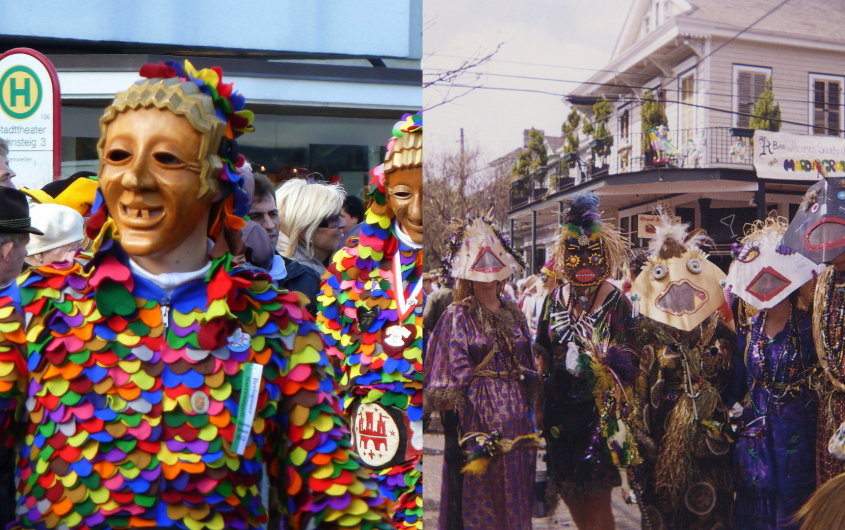
F Delventhal and Infrogmation of New Orleans via Flickr. Images have been changed.
Festivals of Fools

Connor Spruell
Mr. Connor Spruell is a research intern at AICGS for the spring of 2022. He supports resident fellows with their research projects, manages databases, and helps organize and document AICGS events.
Mr. Spruell is pursuing a Master of Arts degree in International Affairs at American University’s School of International Service, with a regional focus on Europe and Eurasia. In his program, he concentrates on issues of nationalism and identity, and his interests include populism studies, nationalism, memory politics, and Transatlantic cooperation and security.
Mr. Spruell holds a Bachelor of Arts in International Affairs from the University of Georgia, where he minored in German. During his master’s program, Mr. Spruell spent a semester studying in Geneva at The Graduate Institute, Geneva, where he was part of an interdisciplinary social science and international affairs program. In his spare time, Mr. Spruell enjoys hiking and reading German poetry.
Mardi Gras and Karneval
In the United States, “Mardi Gras” evokes certain images: wild parties, massive parades with colorful floats, and strings of beads being thrown around. But among the associations and images of Mardi Gras, one doesn’t think about Germany. Outside of the United States, thoughts might turn to the masquerades in Venice or the samba dances of Rio de Janeiro, but not to the Germanic world. However, before talking about Carnival in Germany, it’s important to understand Carnival and its relationship to Lent. Lent is the period between Ash Wednesday (the day after Mardi Gras or Shrove Tuesday) and Easter Sunday. Lent has come to represent Jesus Christ’s 40 day fast in the wilderness where he resisted temptation in order to become closer to God, and during this period, Christians are encouraged to fast, give alms, and confess. Carnival, by contrast, is a period of celebration and excess before the abstention of Lent. Although Carnival and Lent are Christian holidays, Carnival is often more associated with Catholicism (the Basel Carnival in Switzerland is an exception), and like elsewhere, the Catholic regions of Germany predominantly celebrate Carnival.
In Germany, there are different traditions of Carnival, such as Karneval in the Rhineland, where typically the largest German Carnivals are held, and Fastnacht or Fasching in Bavaria and Swabia. Many of these celebrations stem from the Middle Ages, with the first documented Karneval parade taking place in Cologne in 1341. Regardless of region, all these festivals involve shouting “Carnival Greetings,” although the phrase changes depending on the city—in Cologne, one says Kolle Alaaf! (Cologne above all), while in Bremen Ahoy! is more popular.
People in Cologne and elsewhere responded by using Carnival as a subversive act to dress up and parody the Prussians’ stiff militarism, rigidity, and discipline. To this day, satire and parody have remained integral parts of the Rhineland Karneval.
The Cologne Karneval, one the most popular today, expanded in the nineteenth century in response to the growth of organizations hosting parades that culminate on Rosenmontag or Rose Monday (not Tuesday like in the United States), and these celebrations were influenced by the Venetian Carnival where masquerading and parades were popular. Karneval traditionally made use of the figure of “the fool” to signify the holiday and parades often involved an inversion of the traditional hierarchy, where it was the one time of the year that kings and royalty could be ridiculed. During the 1800s, Prussia occupied the Rhineland, and there was always tension with the Protestant Prussians, who viewed those in the Rhineland and Cologne negatively as “French” due to their Catholicism. People in Cologne and elsewhere responded by using Carnival as a subversive act to dress up and parody the Prussians’ stiff militarism, rigidity, and discipline. To this day, satire and parody have remained integral parts of the Rhineland Karneval.
In Bavaria and Swabia, Fastnacht (eve before Fastenzeit, or Lent) and Fasching (feasting), share many similarities with Karneval. Often one or many Narrenzünfte (Fool’s Guilds) organize parades and masked dances. While also influenced by Venice due to close trade ties, these festivities made greater use of folk imagery and grew in popularity in the postwar period. Wooden masks and costumes allow people to play folk roles such as witches, devils, fools, and ordinary people. Individual towns also have their own characters, such as the Oberndorf Narrenzunft (Fool’s Guild of Oberndorf) which makes use of several types of fools with distinctive traits. For example, the Oberndorfer Narro wears white linen pants and gown and carries a rod that holds pretzels, in a nod to the wandering pretzel salesmen of the past. Others, such as the “Polizeischantle” (Policeman), represent authority with his sword and official uniform, and whose arrival signals the close of the Narrensprung or Fools’ Parade, which happens on the Tuesday before Lent. A virtual museum of folk masks has a wide collection from Swabia and Bavaria, with some masks coming from as early as the seventeenth century.
Karneval and Mardi Gras do share an important connection in that they both have developed into increasingly inclusive celebrations. This inclusivity has sometimes been hard-won, and there have been problems with racism.
Karneval and Mardi Gras do share an important connection in that they both have developed into increasingly inclusive celebrations. This inclusivity has sometimes been hard-won, and there have been problems with racism. One of the most popular New Orleans “krewes,” or Mardi Gras organizations, is the Mardi Gras Indians, which was started by African Americans in the late nineteenth century who would disguise themselves as Native Americans to join the segregated festivities. They chose to dress as American Indians because the Indians’ struggle against the tyranny of white supremacy mirrored their own and because American Indians would often harbor escaped slaves. The Mardi Gras Indians also added an important counter-cultural element to Mardi Gras that helped reclaim it from the white supremacist krewes who dominated the festival in the late nineteenth century. They, among many others such as the Baby Dolls, the first women and women of color to participate, have helped desegregate Mardi Gras and krewes and work towards overcoming its racist legacy.
In Germany, Karneval also has a history of racially insensitive practices, such as using blackface and costumes to portray racist stereotypes, which directs the mocking ire of Karneval to “punch down” onto the marginalized, rather than “punch up” against the powerful. In 2017, the Cologne Forum Against Racism and Discrimination with support from the Die Linke (The Left) party among others created an ad campaign called “Ich bin kein Kostüm” (I am not a costume) which advocated against racist caricature in Karneval (this mirrors the problematizing of racist Halloween costumes in the United States, and there has been a debate over the use of black face paint by some Mardi Gras krewes as well). German broadcaster ZDF produced a documentary about the campaign. In the wake of the racially-motivated Hanau shootings, the Cologne Karneval observed a moment of silence to honor the victims, and rather than canceling the event, they decided to press on. Floats were made in memory of the victims in Hanau; one from Cologne depicted the Cathedral crying, and in Dusseldorf a float with a pistol emerging from a man’s mouth had the motto: “Racism – from words come deeds.” Mardi Gras has also used its platform to maintain levity and solidarity during tragedy. During the pandemic, when parades were canceled, people would decorate their homes instead. Germany and the United States share an important tradition that is growing ever more inclusive, ever more respectful, and ever more joyful.
Note: Due to the Russian invasion of Ukraine, the 2022 Cologne Carnival celebrations turned into an anti-war rally in protest.








